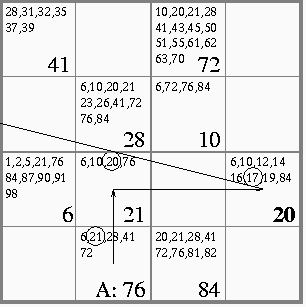Does this project have anything to do with ``grid computing''?
No. The name ``Grid'' comes from the grid-like data structure used
for the GLS location service
protocol. The data structures look something like this: 
Can I get the simulator code used in the GLS or capacity MobiCom papers?
Yes. See our simulations page.
I get an error when trying to compile and/or run your simulation code. What's wrong, and can you help me?
Maybe. Many people have problems configuring and compiling the ns simulator code. Common problems are not correctly setting up the otcl and tclcl distributions. Make sure you have read all the instructions on our simulations page and on the CMU ns page. If you are still stuck, email us and we might be able to help, depending on how busy we are.
I want to extend GLS by adding feature X. What code do I need to change in the simulator?
That depends on what you are trying to do. Unfortunately, since we are busy trying to do our own research projects, we most likely won't be able to help you figure out how to modify GLS to add your specific functionality.
How can I get the Grid protocol implementations (DSDV and geographic forwarding)?
See our software page
Can I use the Grid software for my own networking project?
Yes. All of our code is available as open source.
Can I use the Grid software to run my own community network?
Yes. We currently run our software on an indoor 802.11 network with 22 nodes. Most route are 1, 2, or 3 hops. We also run our software on an outdoor rooftop network in Cambridge, near our lab. We don't have an out-of-the-box set of software for that, but we are working on making it as simple to set up as possible. See our software page for more information about how to set up a network with our software.
What kind of radio hardware is needed to run the Grid software?
Most 802.11 cards (PCMCIA, ISA, or PCI) should work. Mostly it's a question of what devices your operating system supports. Some features of the Grid software might not work with all cards because they depend on modifications made to specific drivers. We use Cisco/Aironet 340 PCI cards on the indoor test-bed network, with the supplied 2 dBi rubber duck antennas. The 340 has a maximum output power of 30 milliwatts. The rooftop network uses the 350 model, which is very similar to the 340 (e.g. same drivers), but has a maximum output power of 100 milliwatts. The rooftop network uses a combination of high-gain omnidirectiona antennas (e.g. the 12 dBi AIR-ANT4121, or the 5.2 dBi AIR-ANT2506), and one directional (yagi) antenna for the link to the Internet (13.5 dBi AIR-ANT1949). Which antennas to use depends a lot on the details of your network setup. The Cisco antenna guide has lots of useful information.
Where can I find more information about your testbed networks?
See our testbed page and Roofnet page.
What if this FAQ doesn't answer my question?
If you have a general question about the Grid project that isn't answered here, email grid@pdos.lcs.mit.edu. If you have a question about our protocol implementations, please email grid-hackers@pdos.lcs.mit.edu